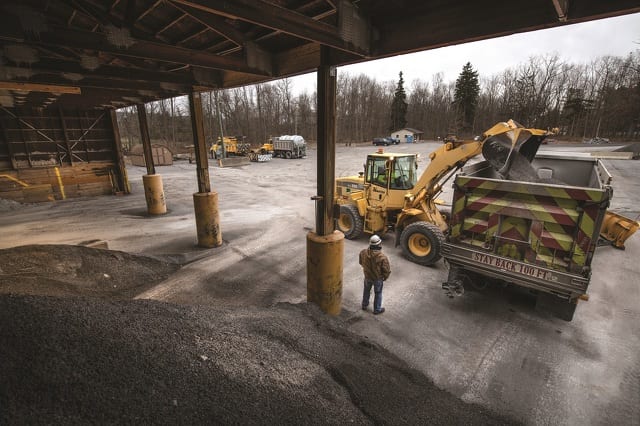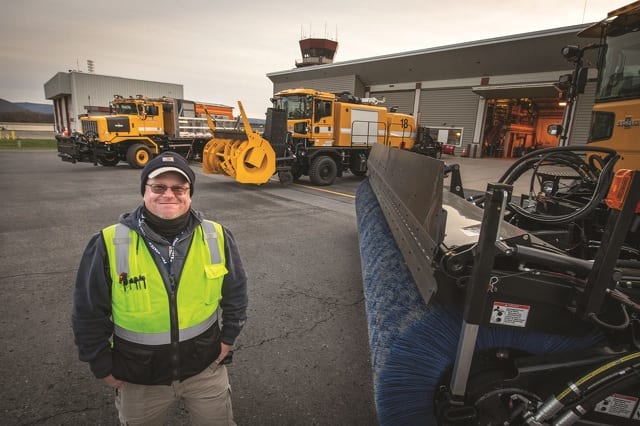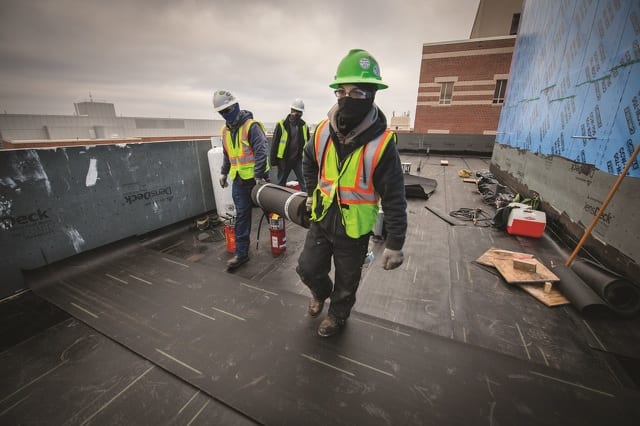Winter is in full swing in Happy Valley, bringing with it that special central Pennsylvania blend of gray skies, extreme temperature swings, and precipitation that can range from snow to sleet to freezing rain on any given day.
We may love it or hate it, but most of us don’t have to work outside in it. So it’s sometimes easy to take for granted everything that has to happen behind the scenes to allow us to do things like drive safely on the roads, take off in an airplane, see a building construction project come to fruition, or even enjoy a day of fun on the ski slopes.
Whether they’re removing snow, making snow, or braving the elements to do their jobs, these winter weather workers deserve our appreciation.
Clearing the roads
The work of our state and local road crews is one winter job that directly affects almost all of us, and yet, as Scott Majot, PennDOT’s acting county maintenance manager in Centre County, observes, “People don’t think about what we do until we don’t do it.”
Keeping state roads safe to drive on during bad winter weather involves a lot more than just sticking a person behind the wheel of a plow truck. It takes an extremely complex operation that includes months of preparation, skilled drivers, high-tech round-the-clock monitoring of road conditions, and intricate planning and coordination.
At PennDOT, winter preparation begins in earnest in October, as salt is stockpiled, brine is mixed, vehicles are calibrated, and drivers go through an intensive two-week training program before performing dry runs on one of the 37 snow routes assigned to each driver.
According to Jeff Cantolina, PennDOT’s assistant county maintenance manager, the training is intensive because salt and plow trucks are sophisticated pieces of equipment.
“There are a lot of things that go on inside our trucks. … Being inside the vehicle can be a big eye-opener for people,” he says.
In addition, drivers need to learn the nuances of each of the roads on their assigned route, so during dry runs, they take note of the locations of potential hazards including low-hanging branches, wires, manholes, and curbs.
PennDOT is responsible for maintaining all state-owned highways, from major interstates like I-99 down to the smaller four-digit state routes. Centre County is one of nine counties that comprise PennDOT’s District 2. Road conditions in all of these counties are monitored constantly at a regional traffic management center in Clearfield.
Before predicted major weather events, PennDOT managers confer with weather services like AccuWeather, as well as with Pennsylvania state police, agencies like FEMA, and other districts across the state. Information about road conditions and closures is automatically sent out to the public in real time via Twitter alerts and on 511PA.com, where the public can observe the conditions of the roads via live feeds from more than 1,000 traffic cameras mounted across the state.
In Centre County itself, it takes two or three hours for a plow to cycle through one route.
“So, if it’s snowing an inch an hour, it’s pretty easy to have 2 to 3 inches of snow on the ground by the time you get back to the start of the route,” Majot says. “Folks don’t always understand that; they want the snow gone as soon as it hits the road.”
However, keeping the roads bare is not PennDOT’s goal, he says; the goal is to keep the roads safe and passable enough to drive on.
Much of what happens at PennDOT is also happening on a smaller scale at the local level. State College Borough’s Department of Public Works is responsible for all of the roads within the borough, including parts of Routes 322 and 26 that it maintains for PennDOT.
Like PennDOT, preparations begin in October, according to acting Public Works Director Eric Brooks, including equipment maintenance and training for equipment operators. Four six-person crews are assigned to routes and shifts for the upcoming winter.
The borough has several different kinds of equipment in varying sizes to handle everything from small alleyways to the larger four-lane roadways, all of which are maintained by two mechanics at the borough’s service facility on Osmond Street. Steve Duck is one of them.
“We split shifts so we have coverage during a snowstorm. That’s when you don’t want something to break. We do our best to check things over really well before trucks go out, but sometimes a hydraulic line will blow or something in the middle of the snowstorm, and we’ll have to go out and lay in the snow and fix it,” he says.
During a storm, each route can take 1½ to 2 hours to clear, depending on the amount of traffic on the roads. It also takes a lot of salt.
“We have about 11 tons of salt on hand at any given time, and up to 5,000 gallons of salt brine,” Brooks says. While a common misconception is that the purpose of the salt is to melt the snow, Brooks says that is not the case.
“The main reason for the salt is to create a bond with the road surface so that the snow doesn’t freeze to the road, so it’s easier for plows to remove it,” he explains.

As with PennDOT, communication is key.
“It’s a total team effort during a big snowstorm, and it takes a lot of coordination. You have to be ready to prioritize and reprioritize while you’re in the middle of a storm,” Brooks says.
Public Works is made up of refuse collectors, sanitary sewer workers, tree crews, street crews, and facilities crews; during a snowstorm, “it’s all hands on deck,” Brooks says. That’s partially because, unlike PennDOT, the borough also has downtown facilities, bike paths, and parking lots to maintain.
“Parking garage roofs and municipal parking lots need to be plowed. Snow that has been pushed to the curb in metered areas downtown has to be removed,” Brooks says. “We’re kind of unique in that once we’re done plowing, our crews have to stay and haul snow.”
That process can take up to two nights, which is why it is important for the public to follow borough rules about not parking on the street during a snow emergency. In addition, Brooks asks the public to refrain from blowing snow back out onto the street when clearing driveways. He also urges patience, as each route prioritizes main arterial roads and thru streets for clearing before less-traveled side streets.
“Everyone would love to be first, but there is a method to our madness,” he says.
Making flight safe from the ground
Winter precipitation doesn’t just affect drivers on the road; it also affects the safety of airplane travel, particularly at takeoff and landing.
Enter Bob Sennett and the rest of his four-person field maintenance team at the University Park Airport.
Although they are dealing with runways versus roadways, many of the same methods that road crews use apply. For example, Sennett’s team uses an environmentally-friendly salt brine to pretreat surfaces. They also remove snow with drivable snow-blowers and plows.
But jets and airplanes require an even more cleared surface for safe landing and takeoff than what would be acceptable on a roadway. So, in addition to salt and plow trucks, Sennett says the crew relies heavily on large drivable brooms to keep runways clear.
“We’ll run those brooms in tandem and take the snow off. The brooms will take it pretty much down to a bare surface. If it gets too much for the brooms to handle, if we get a lot of snow or a wet snow, we have two plow trucks we’ll use to knock the heavy stuff back, and then we’ll follow them with the brooms. … Then we just keep doing that back and forth for as long as the event lasts.”
Aircraft also need to be de-iced for flight safety at the discretion of each pilot. While the airport’s field maintenance and line service crews de-ice corporate aircraft, such as the FedEx planes, the employees of each individual airline are responsible for de-icing the commuter planes.
The field maintenance crew is responsible for maintaining the airport’s buildings and grounds all year-round, so in warmer weather the crew will work on everything from runway and taxiway lighting to grass-mowing to plumbing issues and FAA inspections.
While Sennett says he prefers hot weather to the cold, “You get acclimated to the cold. When you work outside, you just kind of roll with it. Thank goodness for Carhartt!”

‘The colder the better’
While road crews and airport crews are keeping an eye on the weather, so is Tom Matalavage – but for a different reason.
As the mountain manager at Tussey Mountain, Matalavage is responsible for the ski resort’s snowmaking operation. The right weather conditions are crucial for snowmaking, he says.
“The colder the better,” Matalavage says. “Our snow guns don’t put snow out; they put out air and water, and it has to be cold enough to convert that water to snow.”
That ideally happens when temperatures drop to around 25 degrees Fahrenheit, he says, but the air has to be dry as well.
“When the dew points are higher, that makes converting the water coming out of the snow guns to snow harder to do. It doesn’t make very good snow,” he explains.
When conditions are right, Matalavage has two three-person crews to handle the snowmaking. The daytime crew is Tussey Mountain’s regular year-round maintenance crew, the people responsible for things like keeping the chair lifts operational and maintaining the grounds and equipment. The nighttime crew is made up of mostly seasonal workers who are called in as needed.
Most snowmaking occurs in the evening and overnight hours, Matalavage says. It is a physical job that involves hooking up hoses to hydrants and moving large snow guns around.
“You’re exerting yourself pretty well, so even if it’s just 10 degrees out, as long as you are dressed properly and moving around, you rarely feel cold,” he says.
Plus, he says, once the snow guns are set up and running, “It’s kind of like a babysitting job. You can come inside and warm up, have a cup of coffee, grab something to eat. Then you just go out and patrol, and make sure there isn’t an issue with a gun here and there, every half hour or hour.”
Tussey Mountain’s snowmaking equipment can pump approximately 1,000 gallons of water per minute, all drawn from a pond near the pavilion below the ski resort. In the right conditions, the guns can produce several inches of snow per hour. Matalavage says it takes 6 to 8 inches of snow before the slopes are skiable.
With the varied weather in central Pennsylvania, the snowmaking efforts often seem to take two steps forward, one step back, as rainy or warmer days intermittently follow productive snowmaking sessions. But Matalavage says manmade snow is denser and therefore more long-lasting than natural snow, so the snowmaking efforts are rarely wasted completely. Patience is key.
“Covering a ski slope with enough snow to actually open it and groom it and get it ready for the public to ski on, it takes some time. It’s not a race. It’s really a game of mathematics,” he says.
Matalavage has been working at Tussey Mountain for more than 30 years, and making snow for 20 years. While he says there have been great winters and not-so-great winters as far as snowmaking weather, he is reluctant to attribute locally warmer winters to climate change.
“I think it’s really just that central Pennsylvania is an inconsistently cold place. It’s a difficult place to operate a ski area. It’s been a battle ever since I’ve been here,” he says.
Rooftop rewards
Outside on a roof 90 feet in the air may sound like one of the most unappealing places imaginable on a blustery, wintry day, but Kerry Booher speaks about it almost poetically as he describes his job as a commercial roofer with R.H. Marcon Inc.
Booher knows there is a certain inherent danger that comes with his job, especially when cold weather makes surfaces slick and wind gusts blow materials around unpredictably. But to him, conquering those elements, and doing it with a team, makes the job particularly gratifying.
“There’s always a risk. That’s part of the reward, though,” he says. “Just like with other outdoor trades, you are at the mercy of the weather, and when things get cold like this, you personally have to push through it. And when you do, you get this sense of accomplishment, and you look around at the guys you were just pushing through the day with who were in the same situation, and you just smile. Because you have that camaraderie and that bond.”
R.H. Marcon installs roofs on large commercial construction projects, including downtown high-rises such as RISE and The Metropolitan. Booher is currently part of the crew working on the new Henning Building on the Penn State campus. While he says there are certain extreme weather conditions that roofing crews do not work in – including temperatures falling well below freezing, wind gusts exceeding 20 mph, or the threat of lightning – the show must go on whenever possible in order to keep construction projects on schedule.
“Winter construction is not really ideal for the most part, but projects need to get done. … You have this giant, complex structure going up; it’s very intricate, with a lot of moving parts. You can’t do some parts of the job until other processes are complete. So we have to push through sometimes,” he says. “It’s very complicated and difficult, and then you add all these other elements like weather, and I think it’s good for our brain and cognitivity to have to focus. … It’s rewarding. And it’s important. Without a good roof, you’re not going to have a good structure.”
And besides, he points out, “On the good weather days, we get to view the surrounding area from a perspective that most people don’t get. The appreciation for nice weather is amplified when you commonly experience extreme weather conditions.”
Booher says the company stresses safety at all times, from making sure employees stay hydrated during hot weather, to replacing old safety glasses with special, top-of-the-line fog-proof safety glasses when they noticed that face masks worn to prevent the spread of COVID-19 were creating a fogging issue.
Booher lists several keys to staying safe on a roof during inclement weather: “Prepare. Think ahead. Be more mindful. Move a little slower. You have to be cautious, you have to be alert, and you have to watch your team. We’re a family up there. If everybody is accountable for safety, then everybody is going to make it to the end of the day, we’re going to do it together, and it’s going to be glorious.”

Karen Walker is a freelance writer in State College.



